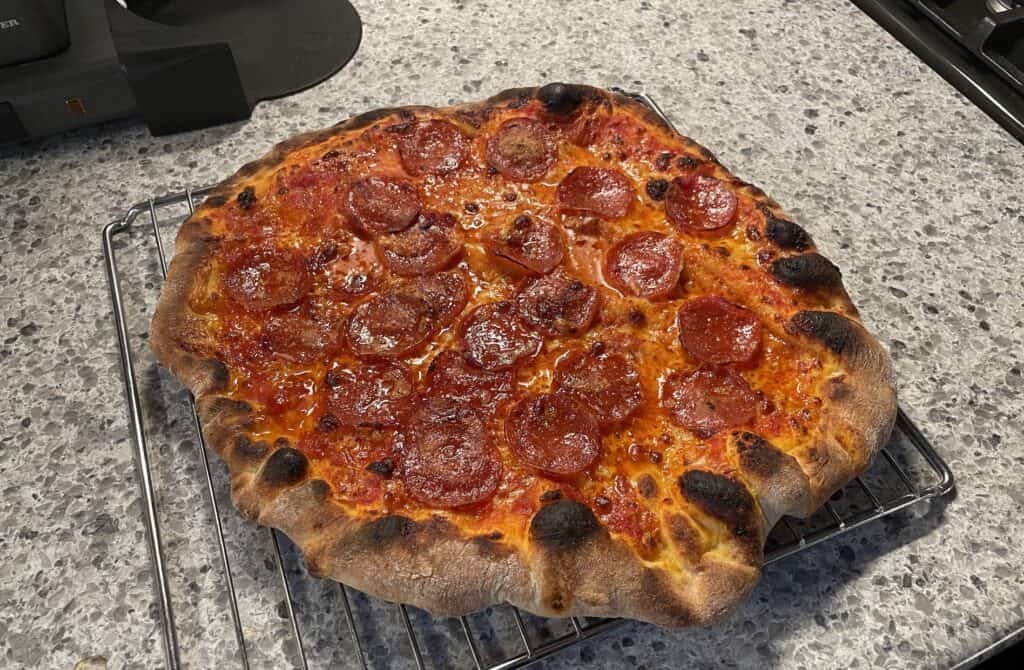So you’re making a DELICIOUS, mouth-watering homemade pizza…
You fire up the oven, cook it--and your cheese comes out funky. 🧀
Argh.
To make the perfect pie, it’s vital to understand how cheese behaves (and take steps to prevent that).
Why is my pizza cheese rubbery?
This is usually a result of overheating or overcooking, but it can be prevented by using the right kind of cheese (low moisture, preferably whole milk). When cheese cooks, the proteins can heat up and squeeze out the moisture, leading to a rubbery or stiff texture. Also, certain cheeses naturally melt better than others!
Fresh mozzarella, for instance, can EASILY break down into rubbery blobs after only a few minutes in a regular oven.
Years of making hundreds of pies taught me that rubbery cheese isn’t the end of the world, but it’s definitely a LETDOWN 😢

I’m here to help you avoid that disappointment.
Keep reading for some cheesy tips 🍕
Why Cheese Gets Rubbery (On Pizza)
The easiest explanation is overheating or overcooking it.
There are two factors at play:
- Moisture
- Time
When you cook the cheese, the proteins start slowly “squeeze” the moisture out of your cheese. The longer you bake it (after a point), the dryer and stiffer it gets.
Each cheese behaves differently (and there’s a massive difference between pre-shredded cheese vs freshly-shredded cheese).
Check out these four trusty tips to help you undo rubbery cheese ⬇️
How Do You Fix Rubbery Mozzarella?
Mozzarella is easily the most popular cheese to use on pizza. Duh.
But the kind you select for your pizza and how you prepare it will make a difference.
Here’s what you can do to fix that (if it should happen).
1 – Buy the Dryest Cheese You Can
The less moisture that can “squeeze” out, the better.
Look for a low-moisture mozzarella – this is super easy to find just about anywhere. Woot!
Also, avoid cheese packed with water. You NEVER want additional moisture.

Note: this will also help your pizza cheese from sliding off.
2 – Avoid “Part Skim” if You Can
The higher the fat content in mozzarella, the better it will melt (and it has a better, stretchy texture).
Though it’s tougher to find, it’ll be worth the effort if you do. If you can’t find this in the normal cheese section of the grocery store, you might check the bakery section (or wherever they have the expensive, fancy cheeses).
3 – Avoid Pre-Shredded Cheese
Yes, these bags are convenient, but they won’t bake well.
They have anti-clumping additives that will prevent a good melt on longer bake times.
Buy a few blocks and shred them yourself. Packaged stuff will never melt as well as if you shred it.
(Also, block cheese is more cost-effective, and it lasts a lot longer in your fridge). #Win.
4 – Dry Out Your Cheese
You can shred the mozzarella ahead of time, place it in a bowl, and then let it chill in the back of the refrigerator for a few hours before baking it.
Your main goal is to avoid excess moisture.
I promise you’ll get rewarded with nicely cooked cheese on your pizza. Keep it dry.
If Using Fresh Mozzarella, Try Adding It After (Or During) the Bake
If you’re a fan of Neapolitan pizza, fresh mozzarella is actually quite different than the “regular” mozzarella.
Pay attention to texture. If your fresh mozzarella is really creamy (or comes packaged with liquid), try adding the cheese just after the bake (it should melt a little from the pizza’s heat).
Better yet, you can actually add it DURING the pizza bake.
- Home oven (500 – 500 degrees F): I add my fresh mozz about halfway during the baking process (3 minutes into a 5-minute bake time)
- Pizza oven (800-900 degrees F): I add the mozzarella BEFORE the baking, like normal. These pizza cook in 60-90 seconds.
I’ve had great success with this. It gets nice and melty but never rubbery.
Experiment with both during and after, and choose what works best for you.
Another hack is to squeeze fresh mozzarella between 2 paper towels. Let it sit and dry out for about 15-20 minutes.
If you’re not going to use it immediately, throw it in the fridge until you’re ready.
What Kind of Cheese Works Best on Homemade Pizza?
There are many options for your pizza, and which cheese works best depends on the type of pizza you make.
Here are three pizza types matched with the best cheese pairings:
- NY style (or other “normal” pizzas) = mozzarella (low moisture, whole milk preferred)
- Neapolitan = fresh mozzarella
- Detroit-style = Wisconsin brick cheese (if you can find it), else a mix of mozzarella and Monterey Jack will get it done. (read more about Detroit-style cheese here)
Use low-moisture mozzarella, preferably whole milk (though it’s hard to find because part-skim is the norm).
Buy the block cheese and shread it yourself, instead of pre-shredded.
You got this, cheese-master!

